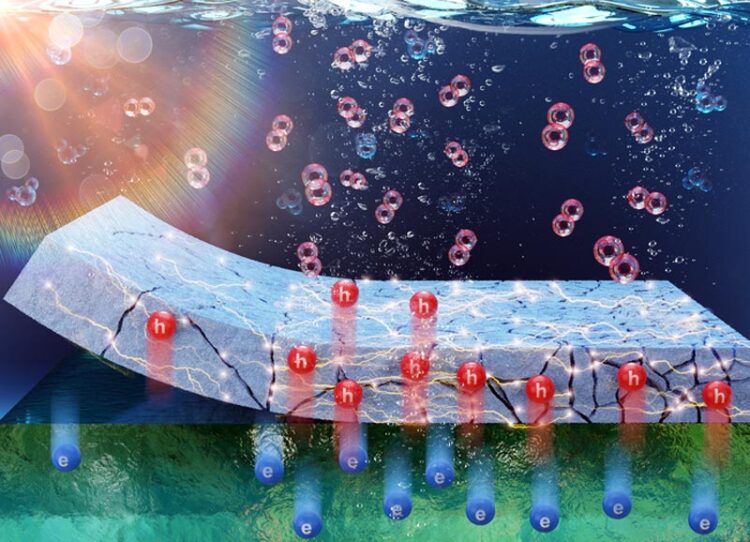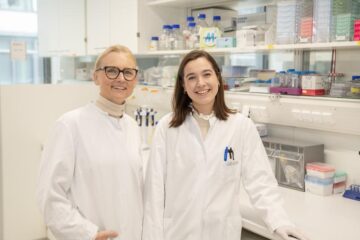KRISS ushers in era of green hydrogen

Highlighting a study on a mechanism of photoelectrochemical water splitting on Si photoanode passivated with TiOx layer with various defect density from the laboratories of Dr. Ansoon Kim at Korea Research Institute of Standards & Science (KRISS).
Credit: Korea Research Institute of Standards and Science (KRISS)
KRISS demonstrated carrier transport mechanism of photoanode with protective film to optimize green hydrogen production, The development can contribute to the realization of carbon-free green hydrogen and artificial photosynthesis.
Hydrogen has been gaining attention as a clean and efficient energy source. However, is hydrogen really environmentally friendly? Most hydrogen commonly used now is “grey hydrogen” derived from fossil fuels. Since its production process accompanies generation of green house gas, it can be said that grey hydrogen is not environmentally friendly in the strict sense. The era of “green hydrogen” without carbon emissions has not yet begun.
The Korea Research Institute of Standards and Science (KRISS, President Hyun-min Park) has demonstrated the key to the longevous and efficient photoanode with protective film, which is used to produce hydrogen via water splitting using solar energy. This is expected to bring forward the era of environment-friendly “green hydrogen.”
Green hydrogen is produced without carbon emissions by using renewable energy sources. A representative method to produce green hydrogen is photoelectrochemical water splitting using photoanode which is directly immersed in electrolyte and can absorb sunlight. As a result, the photoanode directly splits contacting water into hydrogen and oxygen using absorbed solar energy. However, as the photoanode is in direct contact with electrolyte, it is prone to surface corrosion. Surface protective coatings were deposited on the surface to prevent surface corrosion.
Typically, oxide materials such as titanium dioxide (TiO2) are used as protective films for photoanodes. Although oxide materials are poor conductors of electricity, their conductivity can be modulated when oxygen defects, serving as a channel for charge transport, are formed. The key to extending the lifespan of photoanodes is to develop a protective film durable enough to prevent electrode corrosion and capable of maintaining optimal electrical conductivity.
KRISS has developed the world’s first technology for systematically modulating the levels of oxygen defects in a titanium dioxide (TiO2) protective film of photoanode to maximize hydrogen production efficiency. In order to explore the role of oxygen defects in the charge transfer mechanism, the research team determined the optimal levels of defects that maximize photoanode lifespan and hydrogen production by using X-ray photoelectron spectroscopy and electrochemical analysis
Unlike past studies that relied on spontaneously formed oxygen defects in the protective film during manufacturing process, this research proposes a direct method of production that controls the levels of oxygen defects, enabling mass production. According to the experimental results, the photoanode without a protective film showed a rapid degradation in lifespan within an hour, causing the hydrogen production efficiency to fall below 20 % compared to the initial state. On the other hand, the photoanode with optimized protective film maintained a hydrogen production efficiency of over 85 % even after 100 hours.
This achievement has the potential to enhance the efficiency and lifespan of photoanodes and can be applied to other clean technologies that rely on photoanodes. The artificial photosynthesis technology that captures carbon dioxide and converts it to a chemical energy source using solar energy is one of the examples.
Dr. Ansoon Kim, a principal researcher at KRISS Interdisciplinary Materials Measurement Institute, said, “This approach can improve photoanode lifespan by approximately 10 times and significantly contribute to the commercialization of green hydrogen.”
KRISS plans to conduct further research to unveil the optimal levels of oxygen defects and underlying principles that maximize the lifespan of photoanodes.
As the national metrology institute (NMI) of Korea founded in 1975, KRISS (Korea Research Institute of Standards and Science) has developed measurement standards technology and played a pivotal role in upgrading Korea’s main industries to the global level.
Supported by mainly KRISS and partly the Technology Innovation Program of NRF (National Research Foundation of Korea), the study was published on the back cover of Journal of Materials Chemistry A (IF=14.511), an international journal in the field of materials chemistry, on 28th February 2023.
Journal: Journal of Materials Chemistry A
DOI: 10.1039/D2TA07082K
Article Title: Role of defect density in TiOx protective layer of n-Si photoanode for efficient photoelectrochemical water splitting
Article Publication Date: 28-Feb-2023
All latest news from the category: Life Sciences and Chemistry
Articles and reports from the Life Sciences and chemistry area deal with applied and basic research into modern biology, chemistry and human medicine.
Valuable information can be found on a range of life sciences fields including bacteriology, biochemistry, bionics, bioinformatics, biophysics, biotechnology, genetics, geobotany, human biology, marine biology, microbiology, molecular biology, cellular biology, zoology, bioinorganic chemistry, microchemistry and environmental chemistry.
Newest articles

Researchers have found brown fat’s “off-switch
Researchers from the University of Southern Denmark, the Novo Nordisk Center for Adipocyte Signaling (SDU), the University of Bonn and the University Hospital Bonn (UKB) have found a protein that…

Combining robotics and ChatGPT
TUM professor uses ChatGPT for choreographies with flying robots. Prof. Angela Schoellig has proved that large language models can be used safely in robotics. ChatGPT develops choreographies for up to…

How the Immune System Learns from Harmless Particles
Our lungs are bombarded by all manner of different particles every single day. Whilst some are perfectly safe for us, others—known as pathogens—have the potential to make us ill. The…





















